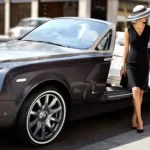Some cars are so expensive that there is no shortage of buyers, and in 10, 15, 20 years nothing has changed. Think Ferrari Enzo, Porsche 918 Spyder and McLaren P1. Others start out as hot property, but they can be bought for peanuts today because no one wants them or at least not enough to risk repair bills. Jaguar XK coupe and R230 Mercedes SL take a step forward.
There are also cars that carmakers have struggled to sell when they were new because they were too expensive, the global economy was in the toilet, or the manufacturer over-promised and did not meet specifications, but buyers refused to buy. today.
BMW Z8
Despite Pierce Brosnan’s supporting role in the James Bond film (or maybe I think that’s why), the Z8 never lived up to BMW’s sales expectations. It looked great, with a retro finish to BMW’s classic 507 roadster from the 1950s and a 395 hp under the hood. (400 horsepower) M5 V8 performance was insufficient.

Related: So you want BMW to go back to its old grid, but which one?
But the Z8 doesn’t have to be a sports car or a GT, and potential buyers don’t seem to know. It drove like a sedan and sounded amazing, but it had a six-speed manual transmission if you didn’t choose the better version of the Alpina, which got a 4.8-liter V8 with automatic transmission.

Sales began in early 2000, when BMW was just over $ 134,000, and by the end of the 2003 model year, it had died, with only 5,703 homes found. But surviving cars are worth a lot of money today: you need more than $ 350,000 to buy the best.
1953-55 Corvette

GM’s commitment to the European sports car did not go unnoticed when it was released in June 1953. In the first year, the C1 Corvette’s six-cylinder engine made it much more powerful than the average MG, but there was no manual transmission. , no color choices (they were all white Polo) and for $ 3,490 it was as expensive as a Cadillac coupe.

It wasn’t until 1956 that the Corvette had a sleek body, a small block of V8 power, the ability to switch to a wand and rotate windows, but although it was still nailed to a new Ford cross, the model stood out on its own. T-bird in sales charts. Ford replaced 15,631 Thunderbirds in 1956, while Chevy replaced only 3,467 corvettes, but that number nearly doubled in 1957.

It is much better to buy late Corvettes, but the rarity and historical significance of the early models means that demand is strong, as well as prices. A ’56 base with a standard H8 on the Hagerty may cost you $ 51,000, but a ’55 running on a V8 will cost you twice as much, and a rare ’53 will cost you $ 166,000 and up, despite its six-cylinder performance for pedestrians.
McLaren F1

McLaren F1 is a modern classic. It showed a gradual change in the performance of the supercar in its 1992 release, so it took years to catch up with the competition in every sense. But while its acceleration time was excellent (0-100 mph / 160 km / h in 6.3 seconds), the F1 time was poor. During the global downturn, it was not a wise idea to build a car that was several times more expensive than a conventional 200-mile (320 km / h) supercar, and by the end of production in 1998, McLaren had assembled only 106 of the 300 cars. planned to do.

But this small production, of which only 64 are road vehicles, is the main driver behind current values, as the number of owners who prefer Formula 1 is much richer than F1 cars. Hagerty estimates that three “good” road vehicles should cost $ 17 million, but last year someone paid $ 20.5 million for an example that is only 243 miles (392 km) per hour.
Chevrolet Camaro ZL1

The 1969 Chevrolet Camaro ZL1 was created only to homologize race cars such as the Plymouth Superbird. But as Plymouth chased NASCAR glory, Chevy’s eye was on the National Hod Rod Association (NHRA) Super Stock drag class. Choose the ZL1 option on the ’69 Camaro order form, then you have Chevy’s first full aluminum V8, a 427-inch (7.0-liter) beast with 430 hp. (436 PS) is undervalued, which is actually about one – fifth lower. The strength and weight are the same as a small 327 small block with half a muscle.

But almost no one has set this option. At first, it wasn’t well-publicized, but even if you know it, you’ll be terrified when you see that the engine itself costs $ 4,160, which makes it more expensive than a car. While the SS 396 is very fast and thousands of cheap (about $ 3,000), and those who want a full seven-liter engine at the front can get an L72 iron block 427 engine, many people don’t understand what it means to pay for it. The Central Office at the back door, which launched the ZL1, only had $ 490 through the production ordering process.

Although NHRA rules require 50 examples, Chevy actually made 69 ZL1 Camaro. But not because buyers are knocking on their door. Fred Gibb delivered 50 vehicles to help implement the Chevrolet program, but at least 30 of them remained unsold and were returned to Chevy for redistribution through other dealers. Fast forward 53 years, but when current ZL1 prices are new, it makes it look like a deal. You are considering $ 600,000 for a decent car (10 times the cost of SS 396) and more than $ 1 million for the show winner.
Lexus LFA

It’s hard to call the Lexus LFA a flop when it’s a supercar with a superb carbon fiber V10 engine during the worst global economic downturn in decades and against Nissan’s incredibly capable and massively cheap GT-R. Toyota has sold all of the 500 it plans to build. But it took about 10 years to make it. When Ferrari announces 500 units of the special item, the cars will go on sale immediately, but Toyota LFA began production in late 2010 and recently in 2019 the cars were still registered for the first time.

Novice buyers may find themselves knocking themselves out for a long wait, as the front-mid-engine chassis layout means the handling is great, and the 552 horsepower (560 PS) V10 naturally sounds great. They may also have to spend far more in 2019 than when the car was sold for $ 375,000 in 2011. Today, LFA can cost you between $ 700,000 and $ 1 million (more with the Nurburgring package), which is 75% more expensive than at the same time last year.
Jaguar type D.


Thanks to the halo effect of cars that have won the Le Mans 24-hour series, which has been on sale since 1955, you will need more than $ 5 million to get a Jaguar D-Type today. But they are not so popular now. At the end of 1956, Jaguar finished the factory race and was left in a pile of unsold cars.

Jag’s decision turned the rest of the D-type racers into road cars, giving them a new body, the right windshield and hood, and a new name: XKSS. Unfortunately, a fire broke out at the company’s Brown’s Lane plant in February 1957, burning nine of the 25 vehicles, but in 2016 Jaguar built nine XKSS sequel models using the original chassis numbers to complete initial production.

Another Jag XJ220 that had a hard time finding buyers. The Jaguar had promised that its supercar would have V12 power and all-wheel drive, but the finished car had a turbocharged V6 and sent its power to the rear axle. These changes, as well as the sharp rise in prices and the arrival of the car in the global recession, mean that buyers have done everything possible to get out of contracts. When production was completed in 1994, Jag assembled only 281 of the planned 350 vehicles, and some of the 281 were unsold, but today they are much needed and regularly exchange $ 650,000.
Plymouth superbird

The 1969 Dodge Charger Daytona and its 1970 Plymouth Superbird sister, Chrysler’s engineers, were there to homologize giant airliners that help NASCAR tracks go around 200 miles per hour (320 km / h). Why do you make them so ugly?

And they are ugly. Come on, they are! We don’t see it because we’re so wrapped up in nonsense and what the cars themselves represent in terms of NASCAR and Detroit muscle history. But objectively, they are much more ugly than grounded cars. That’s why Superbirds were hung in lots of desirable and fashionable looking dealers until the mid-1970s, like a narrow-legged suit and hair lipstick.
Related: Forgotten NASCAR planes stuck in the shadow of Dayton / Superbird

Today is another story. According to Hagerty Insurance, the standard body of the Road Runner with a four-barrel V8 base costs $ 39,400 and the legendary Hemi costs about $ 80,000. But you’re looking at $ 175,000 and $ 338,000 for Superbirds with similar engines.
BMW M1

Since the founding of BMW’s M Division in 1972, newcomer Johan Neerpash has planned to win Group 4 and Group 5 extreme categories, possibly even a Le Mans-powered mid-range sports car. But despite showing the 1972 Turbo concept, BMW didn’t have a mid-engined sports car or production capacity to make it, so he asked Lamborghini to build the M1. Bad idea. The cashless Lambo lagged far behind in development and missed the delivery date of BMW’s first batch of cars in March 1978, allowing the M1 to race in Le Mans that year. BMW terminated the Lamborghini agreement and signed a contract with Bauer to manage production.

To disappoint BMW, changing the rules means that the M1 Le Manda will now have to build 400 cars to compete in Group 5, and that will last forever. To save something from the challenge, Neerpash took a cautious step in persuading the Formula 1 design community to allow the M1 to compete in a single Procar series in each F1 event.

This means a high level of advertising for the M1, but this exposition did not turn into a large sales volume, as it was partly 277 hp. (281 PS) 3.5-liter direct six-horsepower BMW 355 hp. (360 PS) was even more expensive. ) 12-cylinder Ferrari 512 BB. Finally, BMW dealers were forced to sell them below the list price, and production ceased in July 1981 after the release of 454 cars. Forty years later, BMW is no less expensive than this Ferrari boxer. Hagerty valued the 1980 Ferrari 512 at $ 205,000 for good condition and $ 440,000 for the M1.
Tucker 48

Preston Tucker’s Torpedo, or Tucker 48, if you use its correct name, had the same effect on the post-war American landscape as a school science-fiction comic book. The space-era style wore a chassis with a fully independent suspension and disc brakes, a flat six-cylinder engine for the Bell helicopter, and it was reinforced with futuristic safety rules such as an integrated rotating wheel, padded control panel and rotating center headlights.

Related: The only Tucker 48 convertible prototype on Earth is a $ 2.5 million car history.
But the car was accidentally hit by a press conference, it was too obvious that it was underdeveloped, and many wrong decisions, such as Preston Tucker’s purchase of an old Cord transmission and spending a lot of money on overhauling them, allowed the company to burn cash at record speeds. Investment and consumer confidence plummeted when the US Securities and Exchange Commission (SEC) announced that it was investigating Tucker.
By the time Tucker’s assets were destroyed, only 50 Tucker 48 cars had been completed, valued at about $ 4,000, putting them at the level of the middle-class Cadillac or Lincoln, and by 2022 it would be about $ 50,000. But if you want to buy one of these 50 cars. In 2022, you will have to share a much more important $ 1.25-1.8 million.






